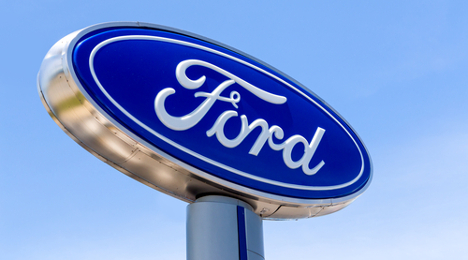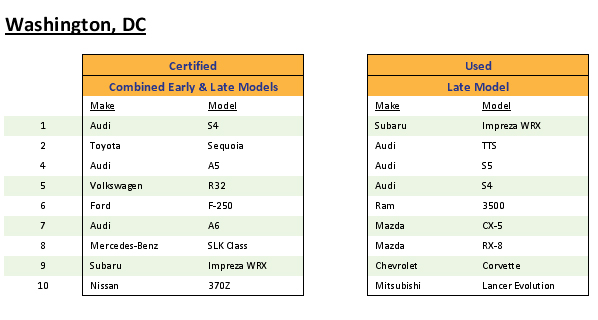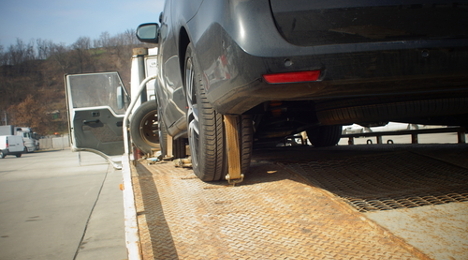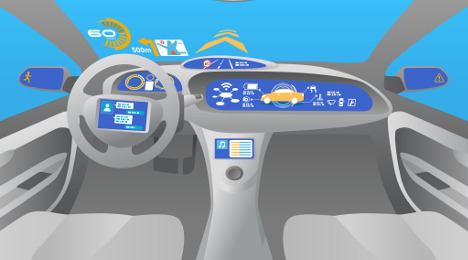NADA University rescheduled a webinar titled, “Increase Profit Through Smarter Advertising,” a session aimed to help dealers attract high quality, profitable sales leads.
The free webinar with presenter Adam Armbruster, senior partner at ESA & Company, is now set for Feb. 10 at 1 p.m. ET. Armbruster will show examples of successful dealerships and how attendees can create a customized growth plan for their business.
“Learn how to attract high quality, profitable sales leads,” NADA University officials said. “Explore real case studies of successful dealerships and create a customized growth plan for your business.
“Armbruster will discuss how the ‘TierZero’ strategy increases net income and ways to improve your media marketing plan,” they added about the 30-minute training session.
Dealers can complete registration for the free webinar here.
Ford Motor Co. announced Tuesday that all Ford Rangers from model years 2004 to 2006 are now recalled for potentially faulty driver-side airbag inflators. This follows news of an estimated 5-million-vehicle expansion of the series of Takata airbag inflator recalls revealed Friday
Ford's action affects a total of 391,394 Rangers, 361,692 of which are in the United States and its territories while 29,334 are in Canada.
A release from Ford says that the company is aware of one report of a death related to a Takata airbag deployment.
The National Highway Traffic Safety Administration discussed the expanded Takata recall in a conference call with the media on Friday, pointing to the fatality of a South Carolina man whose death was linked to an airbag rupture during a wreck involving his 2006 Ranger in S.C. in late December.
According to Gordon Trowbridge, NHTSA's communications director, the recall expansion is due to both this fatality, which he classified as a "field rupture" involving a Takata SDI model inflator, as well as test data showing ruptures in Takata PSDI-5 model inflators.
“That makes that crash the ninth Takata-related fatality in the United States and the 10th globally,” Trowbridge said. “All of these deaths are tragic. There is nothing that we at NHTSA can say or do that will lessen the pain for the affected families. And this latest news is a sad reminder of the immense scope of this problem and why we need to take unprecedented steps to resolve it.”
The model year 2004-2006 Rangers were already under recall for defects in their Takata-sourced passenger-side airbag inflators.
In email correspondence with Auto Remarketing, Trowbridge said that NHTSA believes that Takata's recent filing involving its PSDI-5 model inflators will affect Honda, Audi, BMW, Mercedes Benz, Saab and Volkswagen. The filing involving its SDI model infaltors are expected to affect Audi, Daimler Trucks, Ford, Mazda and Volkswagen.
January has been a busy month for the U.S. government in regards to its transportation system and the automotive industry.
The former announced its long-term plans to bolster its plans to propagate vehicle safety initiatives as well as begin a 10-year action to invest in safe vehicle-automation projects.
While speaking at the Automotive News World Congress on January 12, NHTSA administrator Mark Rosekind made a request to the automotive industry, asking for a more proactive approach to vehicle safety in light of the current era of recalls that it is still suffering.
Rosekind further requested that the auto industry and the administrators do their best to cooperate.
“The era of big recall is not a sign of progress. Record civil penalties are not a metric of success,” Rosekind said. “NHTSA is truly successful not when we catch safety violations and hand down penalties, but when we work together with industry to prevent that kind of crisis from ever occurring in the first place.”
Later that day, during his final State of the Union address, President Barack Obama mentioned his intentions to invest in the nation’s transportation system as part of his budget proposal. Days later, on Jan. 14, U.S. Transportation Secretary Anthony Foxx revealed part of that proposal.
“We are on the cusp of a new era in automotive technology with enormous potential to save lives, reduce greenhouse gas emissions, and transform mobility for the American people,” Foxx said. “Today’s actions and those we will pursue in the coming months will provide the foundation and the path forward for manufacturers, state officials, and consumers to use new technologies and achieve their full safety potential.”
One key element outlined by Foxx is a 10-year, roughly $4 billion investment to assist in the development of safe vehicle automation, via real-world pilot projects. These projects would involve connected vehicle systems in designated corridors throughout the nation, working alongside “industry leaders” to put in place a common, multistate framework for the connected and automated vehicles to operate.
Saying that autonomous vehicles are now feasible and would have “the potential to save lives,” Foxx also unveiled policy guidance to update NHTSA’s 2013 preliminary policy statement on autonomous vehicles.
“NHTSA is using all of its available tools to accelerate the deployment of technologies that can eliminate 94 percent of fatal crashes involving human error,” Rosekind said. “We will work with state partners toward creating a consistent national policy on these innovations, provide options now and into the future for manufacturers seeking to deploy autonomous vehicles, and keep our safety mission paramount at every stage.”
The Department of Transportation is also committing to the following “milestones” for 2016, as listed by NHTSA below:
- Within six months, NHTSA will work with industry and other stakeholders to develop guidance on the safe deployment and operation of autonomous vehicles, providing a common understanding of the performance characteristics necessary for fully autonomous vehicles and the testing and analysis methods needed to assess them.
- Within six months, NHTSA will work with state partners, the American Association of Motor Vehicle Administrators, and other stakeholders to develop a model state policy on automated vehicles that offers a path to consistent national policy.
- Secretary Foxx encouraged manufacturers to submit rule interpretation requests where appropriate to help enable technology innovation. For example, NHTSA responded to an interpretation request from BMW confirming that the company’s remote self-parking system meets federal safety standards.
- When interpretation authority is not sufficient, Secretary Foxx further encouraged manufacturers to submit requests for use of the agency’s exemption authority to allow the deployment of fully autonomous vehicles. Exemption authority allows NHTSA to enable the deployment of up to 2,500 vehicles for up to two years if the agency determines that an exemption would ease development of new safety features.
- DOT and NHTSA will develop the new tools necessary for this new era of vehicle safety and mobility, and will consider seeking new authorities when they are necessary to ensure that fully autonomous vehicles, including those designed without a human driver in mind, are deployable in large numbers when they are demonstrated to provide an equivalent or higher level of safety than is now available.
Following these announcements, John Bozzella, the president and chief executive officer of Global Automakers, a Washington-based trade association and lobby group for various automotive companies, applauded Foxx’s vehicle safety and autonomy plans.
“Our members’ continue to make substantial investments in automated vehicle research and development,” he said. “This technology promises to bring significant benefits for improving personal mobility, vehicle safety, fuel efficiency, emissions and highway congestion. We are pleased the Agency has announced a plan to develop a model state policy to help remove the roadblocks to innovation that can occur with a patchwork of state legislative and regulatory requirements.
“The way in which policymakers address automated vehicles will have a profound impact on the way this game-changing technology can be tested and deployed, not only in a particular state but nationwide,” he continued. ”It is important that any policy is consistent and balanced so it not only reflects the current state of technology, but also is flexible enough to adapt as our industry continues to innovate.”
Stay tuned to Thursday's Auto Remarketing Today PM as we dive a bit further into other happenings in our nation's capital, including recent safety moves made by consumer advocates as well as a couple of manufacturer's new internal roles created in response to growing safety concerns.
Although there have been plenty of articles written about how to prepare vehicles for shipment and how to save transportation costs and time, not a lot has been written about the other end of the process: how to receive shipments at your dealership.
It doesn’t make sense to spend a lot of time and money arranging for transport only to encounter difficulties at the final destination.
To help ensure easy deliveries, I’d like to offer the following tips on how to prepare your dealership to receive vehicle shipments.
- Have an allocated delivery drop area
- This will help ensure a safe unload of your vehicle(s) while maintaining the safety of the driver, your staff and your customers.
- As a rule of thumb, drivers need at least 150-175 feet of clearance (that includes the length of the truck).
- Communicate with the transport company
- It’s always good to communicate any changes in delivery area or receiving hours to your dispatcher to avoid delays.
- You’ll also want to let your dispatcher know of any changes in infrastructure (e.g., different entry gates, low-clearance bridges, major road construction) in your area.
- Having a point person ensures that the right vehicles are delivered to you. There are times a driver arrives at a dealership and can’t unload because he can’t find a person who knows about the delivery.
- Inspect your vehicles
- When your vehicles arrive, make sure to do a thorough inspection with the driver present. Drivers should perform an inspection at the time of pickup and note any existing damage, if any, on the Bill of Lading. When the origin of the shipment is an auction, any damages found are noted on the vehicle gate pass. Use the BOL to note any damages on the vehicle. The driver will keep a copy of this “condition report,” as will you. Sign the BOL only after you’ve inspected the vehicle.
- If your dealership accepts deliveries after hours, the BOL will have a “Subject to Inspection” stamp or signature written on it. As soon as you are able to take physical possession of the vehicle, you should still do a thorough inspection.
- If you see damage, take pictures and contact the claims department at the transport company as soon as possible. Even if you do not have pictures, the sooner you report the damage to the claims department, the better.
- Signing a clean BOL, or not having one at all, will make it very difficult to file a claim.
- Also keep in mind that normal wear and tear on a pre-owned vehicle is not considered major damage. Defining what constitutes normal wear is perhaps a good topic for a future article.
- Check the driver’s paperwork
- When a carrier arrives at your dealership, have your point person check the BOL to make sure the driver is at the correct location, and verify the vehicles that are intended for your business. A carrier can have a full truckload but only one or two vehicles may be for your location.
- Many times a carrier is transporting two or three vehicles of the same make and model. Always verify that the VIN number on the BOL matches the VIN plate on the vehicle.
Following these steps will ensure a smooth delivery process, and you don’t have to wait until your next order to notify your dispatcher of any changes.
Martha Garcia-Perry is director, account management with MetroGistics (www.metrogistics.com).
When you’re driving down the road, how many of the cars in motion around you are being physically driven by fellow humans? More often than not, all of them.
Thinking of an answer to this question, today, may seem quite silly. By the time our millennial readers are old and gray, however, it won’t be.
It’s well known that a variety of auto manufacturers and outside technology companies are preparing for the day that autonomous driving becomes mainstream.
In fact, a small percentage (8 percent) of the 175 automotive executives in 21 countries that IBM surveyed in its Automotive 2025: Industry without borders study think autonomous vehicles will be in mainstream use as soon as in the next 10 years. A much larger percentage (38 percent) think they will at least be in limited use in the mainstream market.
“But how does that affect my dealership today?” you may ask.
Well, there are plenty of autonomous features that are currently hitting the mainstream — and consumers want them. The technologies may not be driving the cars for us yet, but with lane-departure warnings, autonomous braking, and guided cruise control, it’s safe to say we’re perhaps not that far from it.
Autotrader recently presented the findings of its 2016 In-Vehicle Technology Shopper Influence Study at the 2016 International Consumer Electronics Show (CES) and a not-so-surprising percentage of consumers would like more autonomous features in their vehicles.
After surveying a panel of over 1,000 vehicle owners online last year, Autotrader found that 70 percent of the consumers surveyed are more likely to consider a vehicle with autonomous features, such as parking assistance, collision avoidance and automatic braking.
One interesting finding, fleshed out by Autotrader’s associate research manager Rachelle Petusky, is that these in-car technologies are changing what many consumers perceive to be a luxury vehicle.
“When we ask consumers about what defines a luxury vehicle, traditionally in the past consumers have broken it out by automakers that play in the luxury space, such as Audi or BMW,” Petusky said. “But technology’s really changing the game, and non-luxury vehicles are starting to be viewed as a luxury vehicle because of the technologies offered in the car. Things like Wi-Fi, lane change assistance, collision avoidance are helping consumers perceive non-luxury cars as luxuries.”
Since this is the second year that Autotrader has conducted this study, Auto Remarketing asked Petusky what the biggest change Autotrader has seen seen in consumer expectations over the last year.
Petusky pointed to the 77 percent that want a car with all of the technology features they want regardless of car color.
“Probably the biggest change that we saw was the fact that technology is becoming even more important than car color,” Petusky said. “Car color, I think, has been a part of a huge conversation. It still is very relevant in the purchase decision, but technology is definitely going to have more of an impact now than it did last year.”
While Autotrader finds that the majority (60 percent) of the consumers surveyed think self-driving vehicles are a dangerous idea, there are plenty that are more than willing to pay extra for the new technologies that are out today.
Forty four percent of those surveyed said they would pay up to $1,499, which Petusky says is a bit of a “magic number” in the technology package pricing game, for an in-vehicle concierge service. And 65 percent said they would switch brands to get the features they want.
On that note of branding, while Petusky says that in the immediate term it isn’t that cost effective to upgrade used vehicles with some of the new features that are coming out, the used cars that are most popular in the future will be heavily dependent on who adapts what technologies in their new vehicles now.
“But I think as automakers and technology companies figure out how to make it more cost-effective, it is going to start shifting consideration,” she said. “We’re already seeing some consumers that are shopping for new cars that are going to switch brands if the technology that they want isn’t in the car that they want.
“So I think even as people are looking at used cars, it may change which used car they’re considering depending upon which manufacturer is earlier to the game to introducing new technologies in their cars.”
These new technologies are also expected to not only change how automakers certify used vehicles in the future, but also impact the value that used cars retain.
“I think there’s definitely certain things that they’re going to have to check to make sure they’re functioning properly,” Petusky said. “Our sister company, Kelley Blue Book, is actually seeing that vehicle technology is impacting the valuation price of used inventory.
“I think that vehicles that are in good or excellent condition that have that additional technology in the car, it’s just going to be a way that they can ask for a higher price point and that inventory is going to move faster compared to certified inventory that doesn’t.”
Petusky also thinks that dealers and aftermarket companies that can add some of the more affordable new technologies, especially backup cameras, to older vehicles, can reap the benefits.
“That’ll really be a way to differentiate themselves from other dealers,” she said.
There is one feature that customers don’t necessarily care for their vehicle to have completely integrated: navigation. Fifty seven percent said they would rather manufacturers focus on better integration with their smartphones, while 39 percent said they would prefer the navigation system on a smartphone rather than one built into the vehicle.
“We definitely see it continuing to swing toward people wanting to just use the navigation system that’s in their phone,” Petusky said. “But they are wanting that to easily integrate into the dash. Some of the other apps and functions that people are doing on their smart phones now they are willing to surrender to the dash.”
With more than 235 model options in the new-vehicle marketplace, customers shopping in that arena are a bit spoiled for choice. Understanding what customers are drawn to, and, perhaps more importantly, turned off by, can be what sets a good car apart from a great car.
That’s where the annual J.D. Power Avoider Study comes in, and this year its analysis has shown an increased concern for vehicle reliability.
According to the study, which surveyed nearly 26,500 owners who registered a new vehicle in April and May of last year, 55 percent said that vehicle reliability was a leading reason for their purchase, up from 51 percent in the previous year’s study.
Looking at it from the opposite angle, 17 percent said perceived reliability was a chief reason why they avoided a certain vehicle, versus 14 percent the previous year.
"Though vehicle reliability and durability have improved significantly over the years, they remain a vital consideration for consumers," said Dave Sargent, vice president, quality practice, J.D. Power. "With so many auto recalls in the news and challenges with the introduction of new technology, consumers are even more attuned to the expected reliability of new vehicles.
“This impacts which models consumers avoid and which ones they ultimately purchase,” he continued. “Bad news can tarnish an automaker's reputation in an instant, yet, can take years to build back up. Automakers need to convince consumers of the true reliability of their vehicles so it is not a reason to avoid selecting a particular model."
Above reliability, exterior and interior styling still remain the top two most frequently cited reasons for buying a vehicle.
Lower gas prices also appear to have made an impact on consumer preferences, as J.D. Power points out that 51 percent of shoppers factored in fuel economy when purchasing their vehicle in 2015, down from 55 percent in the previous year.
Although nothing new, another issue that has stuck around is the fact that some shoppers tend to change brands because they simply want to try something new.
"This is a major challenge for auto marketers," Sargent said. "In the auto industry, building consumer trust, loyalty and advocacy is paramount to ongoing success. However, there are so many great vehicles available to consumers that merely satisfying your customers is simply the cost of entry.
“To truly succeed, automakers must keep their exterior and interior designs fresh, ensure competitive performance and fuel economy levels, offer an array of advanced technology and achieve an excellent reputation for vehicle reliability."
Here are a couple more key findings from the report, as listed by J.D. Power:
- Car Buyers Doing Less Window Shopping: Since 2012, new-vehicle buyers are considering fewer models and shopping fewer dealers. On average, buyers physically shop only three models, one of which they buy.
- Domestic Brands vs. European and Asian Brands: There remains a significant disconnect between perception and reality regarding the reliability of domestic brands compared with European and Asian brands. Avoidance of domestic models due to reliability concerns (24 percent) is nearly twice that of European (13 percent) and Asian (12 percent) models. In reality, the actual reliability of most domestic models is competitive with that of their import competitors.
Businesses today, large and small, are facing what seems to be the most impatient generation of humans ever when it comes to commodity acquisition. They know what they want and they want it now. And that impetus also extends to their vehicle purchase transaction — which they want to be quick and painless.
This is not “new” news, so to speak — companies like AutoNation and General Motors, among many, are trying a variety of new processes to make it simpler and easier for customers. They understand that if it’s easier for the customer, it’s easier for the dealership. Quicker sales equal quicker profit possibilities.
That sense was reiterated by dealers surveyed by eLEND Solutions, who released the results of a study today that it conducted online among U.S. dealerships in November.
Their findings show that those surveyed, despite wanting things to move quicker, are still saying that the sales process is taking, on average, three hours or more to complete.
Here’s a breakdown of eLEND’s survey:
- 85 percent of dealers think it would be ideal to bring the car-buying process down to two hours or less (up from 59 percent in 2014).
- Since eLEND’s similar survey in 2014, dealers, overall, are not showing much of a change in the speed of the sales process. In 2015, 42 percent said the average sale, from start to finish, lasts 3 to 5 hours. Forty percent said the same in 2014.
One key issue that many dealers — 86 percent — fleshed out in the survey is their issues with vendor integration. This majority of dealers agreed that they experience a significant obstacle in the lack of integration and data exchange between their vendors’ systems, hampering the connection between their online tools and their in-store processes.
This 86 percent agreed that improved cooperation and data sharing could eliminate online to in-store information disconnects and bottlenecks.
“The survey confirms that the sales process can’t evolve — or speed up — unless vendors start connecting the online and offline dots, yet the lack of systems integration means that dealers are unable to embrace new processes,” said Pete MacInnis, chief executive officer of eLEND Solutions. “The way to shorten the customer sales journey — and sell more cars in the process — is to create seamless, real-time integrations between the dealer website, CRM, Desking/Finance and DMS platforms.”
Unfortunately, many of the dealers surveyed are not very optimistic in the idea that this may actually be addressed. 54 percent of the dealers said that it is only somewhat likely and 19 percent said it was unlikely that this type of cross-platform integration may actually come to fruition.
Here are a few more highlights from the survey, listed below by eLEND Solutions:
- Of those that think open integration is unlikely, competition and protecting the status quo were cited as the top reasons.
- 86 percent of dealers strongly agreed or agreed that vendor cooperation and coordination could facilitate a greatly reduced start-to-finish transaction time.
- Nearly 60 percent of dealers agree that specialized best of breed solutions are the way to go because of their higher product quality and service levels (70 percent).
Many companies, including dealerships, tend to tout company culture as part of their recipe for success.
Not very many, however, tend to survive three generations of familial torch bearing and reap the rewards quite in the same way as Ohio’s Ricart Automotive Group.
It started with Paul Ricart on Independence Day in 1953 as a single-point Ford franchise in Canal Winchester, Ohio — with four cars and one garage.
And these days? In late 2015, the dealer group was expecting to have retailed roughly 8,500 used vehicles out of its Ricart Used Car Factory by the end of the year.
As part of this year’s “Leading Dealer Groups” issue, Auto Remarketing spent some time talking with Rick Ricart, third-generation member of the group as well as its current vice president of sales and marketing, to see if he could share some sales tips.
Cutting straight to the issue, we asked Ricart what his group’s overall sales strategy is, distilled down into one statement.
“We are very, very consistent with everything we do. We have consistent training. We have a consistent culture,” Ricart said. “But we are dynamic when it comes to each individual customer as we engage them because there are so many types of buyer today depending on how much research they’ve done and everything.
“I would say our strategy is, ‘sustainable growth through consistent processes, by treating each individual customer based on their needs and demands.’”
Well, that seems to make sense — consistent culture, dynamic approach to customer service — but how is that achieved? To start off, Ricart says one key to obtaining quality sales men and women for his new and used stores is to, well, not hire people who have done it before.
“Four years ago now, I adopted a policy where we don’t hire car salesmen,” he said.
How does that work? For starters, Ricart says they don’t hire the “transient” car salesmen that tend to bounce around from dealership to dealership, spending six months or so at one business before moving on to the next — an issue that he says has plagued the Columbus area in the past.
“What we decided was we were sick of hiring people that had been taught bad habits, that had been taught to lie, cheat and steal,” Ricart said. “What we really need are people that are focused on customer service and that don’t have the entitlement of a lot of millennials that refuse to work 40 hours a week, or work weekends, or work nights. So four years ago we took a strategic move and started hiring from the service industry.”
That’s right — former servers, bartenders, hotel front-desk staff, valets — that’s the Ricart sales staff’s bread and butter.
“We found people that have the personality, the customer service training, the character — and brought them into the car business,” he said.
To Ricart, today’s business isn’t about learning how to be a salesman. It’s about letting the customer, who, more often than not, has come into the store following an incredible amount of research, take the reins and have the sales staff simply help them find what they’re looking for.
In fact, that’s exactly how Ricart’s management phrases it to their sales staff. Of Ricart’s 550 employees across its new and used stores, 62 are sales people in the Ricart Used Car Factory. And they’re not allowed to sell anything.
“That’s what we tell them all the time, ‘you’re not to sell a car today. But you’re to let two or three people buy a car that you meet,’” Ricart said.
‘Family owned and people driven’
That “internal tagline” is what Ricart attributes to his company’s cohesive culture — the reasoning behind its ability to retain many of its employees long term and give them a feeling of openness and honesty.
“We are very employee-centric. We don’t shun them for sharing ideas, criticism,” he said. “We let our employees take ownership in their job and the dealership itself. And we have a lot of long-term employees that help reiterate all of those culture-based programs that we do. And we actually have an in-store employee engagement director.”
In an environment where employees take ownership of their positions and care for the overall well-being of the business, Ricart says this helps make his job easier.
“It allows me to do my job better because I’m not worried about what I say, because everything is very honest and transparent and open with everyone,” he said. “Management truly defends the employees, as well.”
Another tip that Ricart gave for dealers is that if you want to build a fan base for your dealership, you have to start with your own employees.
“We learned years ago when we started our culture change that if the employees aren’t advocates of the dealership the customers never will be,” he said “That sounds crazy, but I remember five years ago there’d be someone that worked in the service department that didn’t want to buy a car from the company they worked for because they didn’t get along well with the used-car department.
“It gave us a lot of opportunity to improve those things. You need to make sure that every employee is proud of where they work.”
Success of the used-car recon department
Speaking with Auto Remarketing in late December, Ricart said the turn-time that week in the Ricart Used Car Factory’s reconditioning department was currently 5.2 days, with its peak at one point as low as 3.9 days. The recon team, which utilizes the Motor Trend Certified Vehicle program, tries to get each vehicle show-ready in less than four days so it can go into the “photo lab,” where each vehicle gains 27 high-quality photos and is put online for sale.
Ricart says he enjoys the program because, instead of having six different teams, one for each make, he has one team certifying all of the Factory’s vehicles. That one team, with 20 technicians designated to used vehicles, shares 14 service bays and performs the same inspection on each vehicle. He says the recon department has come a long way — when they first started tracking turn time on vehicles, they stood at 11 days.
The goal of “sustainable growth” is exactly what is reflected in his Used Car Factory’s sales figures. At the end of November, it had sold exactly 7,787 used vehicles in 2015, an over 700-vehicle increase over the first 11 months in 2014 (7,054 used-units retailed) and roughly tying the overall sales figure for 2014. Speaking conservatively, Ricart says the Factory was expected to end the year at 8,400 to 8,500 used units retailed, a 10-percent jump over last year’s figures.
Ricart says he knows the Factory could retail quite a bit more — but the focus is currently on quality over quantity.
“We’re looking for sustainable growth,” he said. “We could go buy a whole bunch of cars as cheap as we can and lose money to market them and say, ‘Hey, we sold 10,000 cars this year.’ But if you don’t sell 10,000 or more next year, then it was false pride, or whatever you call that.”
The Columbus Fair Auto Auction has named a new director of dealer sales to start the new year.
As of Jan. 4, CFAA’s new director of dealer sales is Brent Branson, who will report to Tim French, the company’s vice president of sales.
“Brent brings a disciplined dimension to our team,” said Greg Levi, CFAA’s chief operating officer. “I have known Brent for years and his relationship skills are as good as his attention to detail. He focuses on the right things, be it customer development, employee mentoring, or operational efficiencies.”
Branson brings over 10 years of automotive industry experience to the position, including time spent as a buyer and as a team leader. Most recently, Branson was the senior buyer at CarMax, where he led teams at various auctions, including Columbus Fair and the CarMax dealership group.
“I am a car guy by trade, but my passion is making people successful,” Branson said.
Final days of this year’s Warren Young Sr. scholarships
In other auction news, the NAAA Warren Young Sr. Scholastic Foundation makes 12 scholarships available each year to eligible NAAA member auctions and corporate office full-time employees, their children, stepchildren and grandchildren.
The window for this year’s scholarships ends Feb. 1.
Four of the scholarships, each worth $3,000, are for two-year schools or auto-related degrees at vocational/technical schools. The other eight are each worth $5,000 for use at four-year schools.
For more information on the program or to start the application process, click here.
Many people enjoy the convenience of having a car at their disposal. But the traditional ownership model may not be doing it for many consumers, who, in a recent study by IBM, are showing interest in other forms of ownership and car-usage methods.
In its study, titled A new relationship – people and cars, the IBM Institute for Business Value performed an analysis on findings from over 16,000 respondents around the world, trying to figure out how people expect and want to engage with automobiles in the future.
Let’s break it down. Of the people surveyed by IBM, 86 percent said they plan on owning a car sometime during the next 10 years, including some of the 14 percent of people that say they can’t afford to buy a car today. Five percent said they will not own a vehicle but will continue to actively drive one.
Here’s where we get into the traditional ownership models. Forty-two percent of those polled say they are very interested in subscription pricing for a vehicle. Another 24 percent are very interested in fractional ownership of vehicles.
IBM also took a look at mature and growing markets around the world, juxtaposing the two to see what is more important to the average driver in a growing auto markets, like India or Brazil, compared to mature ones, like the United States or Japan.
What they found was that the growth markets consistently ranked “self-enabling” vehicle functions higher than respondents in mature markets. For example, 68 percent of the respondents in growth markets said they would be interested in “self-healing” vehicles, i.e. vehicles that have self-diagnostics and perform their own preventative measures, compared to 48 percent in mature markets.
Other self-enabling functions of vehicles that future vehicles may be capable of that respondents are interested in include “self-socializing,” “self-learning,” “self-driving,” “self-configuring,” and “self-integrating” vehicles. In all of these segments, however, more interest was shown from developing markets than mature ones.
"Today's vehicles have transformed from a mode of transportation, into a mobile data center with onboard sensors and computers that capture volumes of information about the vehicle and its surroundings," said Alexander Scheidt, global automotive industry leader at IBM Global Business Services. "Successful automakers will recognize the opportunity to accommodate for this disruption by offering the digital experiences and services that consumers desire."
To check out the full content of IBM’s report, download the file here.












